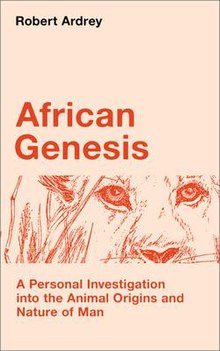African Genesis
 |
|
| Author | Robert Ardrey |
|---|---|
| Illustrator | Berdine Ardrey (neé Grunewald) |
| Language | English |
| Series | Nature of Man Series |
|
Publication date
|
1961 |
| Pages | 380 |
| ISBN | |
| Followed by | The Territorial Imperative |
African Genesis: A Personal Investigation into the Animal Origins and Nature of Man, usually referred to as African Genesis, is a 1961 nonfiction work by Robert Ardrey. It posited the hypothesis that man evolved on the African continent from carnivorous, predatory ancestors who distinguished themselves from apes by the use of weapons. The work bears on questions of human origins, human nature, and human uniqueness. It has been widely read and continues to inspire significant controversy.
African Genesis is the first in Robert Ardrey's Nature of Man Series. It is followed by The Territorial Imperative, The Social Contract, and The Hunting Hypothesis. It was illustrated by Ardrey's wife, the South African actress and illustrator Berdine Ardrey (née Grunewald).
Robert Ardrey, at the time a working playwright and screenwriter, travelled in 1955 to Africa, partly on the behest of Richard Foster Flint, to investigate claims made by Raymond Dart about a specimen of Australopithecus africanus.
He met Dart in March 1955. Dart, in his laboratory at Witwatersrand University Medical School, had assembled evidence for a controversial thesis. Among the collection were fossil baboon skulls from the caves of Taung, Terkfontein and Makapan that he believed showed fractures caused by Australopithecus wielding bone clubs; the jaw of a juvenile ape-man from Makapansgat which had been fractured and lost its incisors; and 7,000 fossil bones from the Makapansgat cave. Among the fossils, skulls and lower leg bones were disproportionately represented, leading Dart to theorize that man's ancestors were hunters who used bones as weapons. His overall thesis was that "it was the ape-man's instinct for violence, and his successful development of lethal weapons, that gave him his dominance in the animal world from the very beginning. Those instincts are with us today." Ardrey was initially much taken by the theory. As a correspondent he wrote an article about it for The Reporter. After receiving significant attention the article was reprinted in Science Digest, which marked the beginning of the spread of popular notions about Australopithecus. The article in Science Digest also led to The Smithsonian Institution contacting Dart and eventually providing him funding to continue his research.
...
Wikipedia
